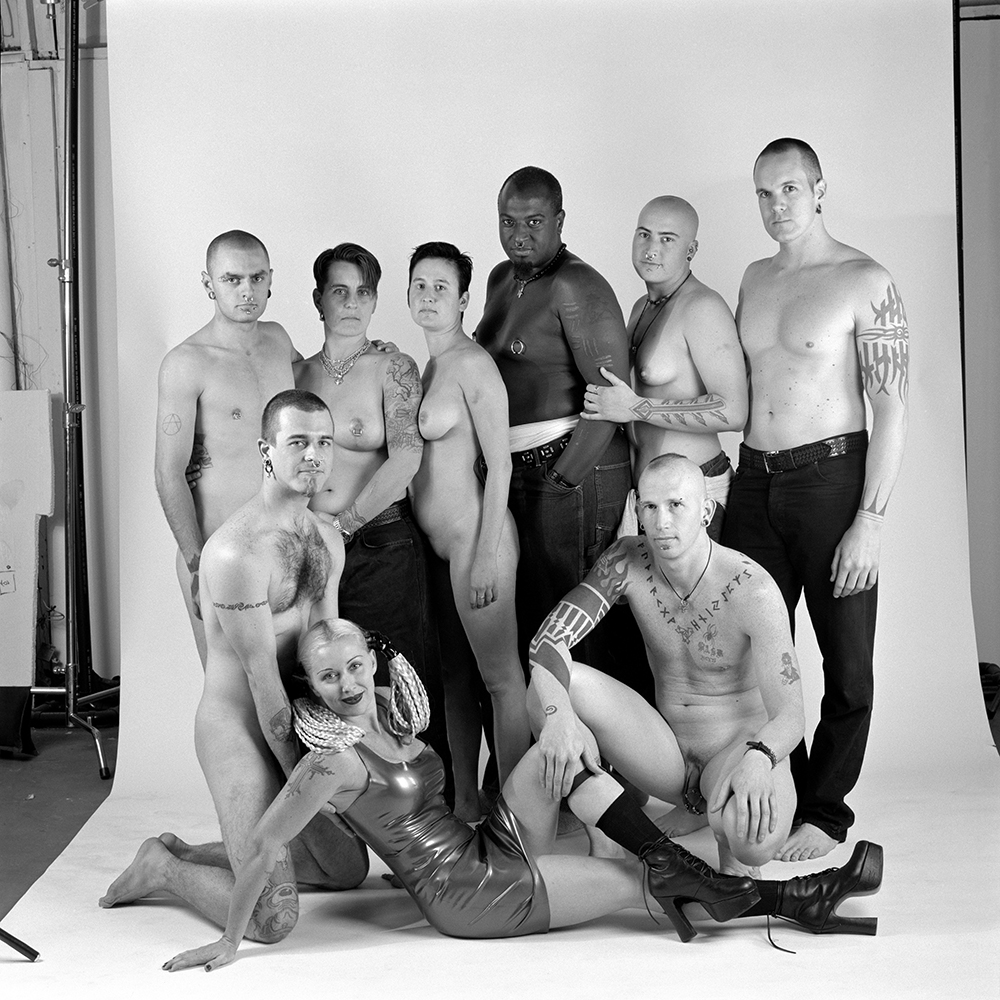In a photograph titled Idexa and Denix, 2002 (2002/2024), a woman in a tight black T-shirt, with tattoos poking out from under the sleeves, short coiffed hair and a nose ring, among other piercings, stares with striking blue eyes at the camera. On her lap is an infant, Gerber-baby-esque with little pursed lips, whose similarly striking blue eyes suggest a mother-offspring relationship. The two sit in a classical pose resembling that of the Madonna and Child—the baby even has a 15th-century look to him. But the legibility of the image as an iconic representation of femininity and motherly devotion is disrupted by the mother’s butchness, moving the photo toward something more strange.
A number of photos in Catherine Opie’s exhibition play with this tension between the conventional and the “unconventional.” The show spans 30 years of Opie’s career, presenting more than 60 unseen photos from some of the famed series that solidified her as a distinctly Los Angeles photographer. In the installation, Opie constructs a personal map of how the city might exist in the artist’s memory—the intimate photos of lovers or friends buried in the center of her mind, surrounded by landscapes.
Documenting a changing Los Angeles, Opie proposes a vision of the city far from depictions that center around Hollywood, Venice Beach and the milieu that surrounds these fantasies of Los Angeles. Instead she captures intimate interiors, friends, lovers, construction sites, bridge developments, freeways—the things that make up real life in LA.

Catherine Opie, Cathy, desert edge, 1987, 1987/2024. © Catherine Opie. Courtesy of Regen Projects, Los Angeles.
Photos of kink scenes or parties like the ones of The Palms, a longstanding lesbian bar, are contrasted with scenes from a more settled, domestic life, as well as images that lie somewhere in between. There’s Sunday Morning, 1989 (1989/2024), in which a naked woman with a funky haircut lies in bed with the blinds closed; the scattered clothes, shoes, handcuffs and water in a big jug surrounding her suggest a wild Saturday night. It’s followed by portraits like Stanya and Harry, 2005 (2005/2024), where the pregnant couple—the carrying partner naked with arms cradling her belly—pose together as if for a department-store portrait.
While simultaneously addressing the changing physical environment around her, with photos of a constantly developing city, Opie also captures a period of aging and social flux: a time when friends slow down with fewer wild Saturday nights, move from houses with roommates to a home with a partner, nesting in anticipation of a child. Yet even a photograph of Opie’s own child, who stares softly at the camera next to a stuffed turkey, Oliver/Thanksgiving, 2004 (2004/2024), in a conventional domestic scene, possesses an eeriness, possibly an ambivalence about such traditionalism. Like the photo of Idexa and Denix (2002), the bourgeois scene is made strange.
The exhibition suffers perhaps from the inevitable nostalgia that occurs in capturing any ’90s scene that has since dispersed or ceased to exist. The transgression of Opie’s and her subjects’ social world has perhaps grown limp—it’s no longer Saturday night, it’s Sunday morning.


